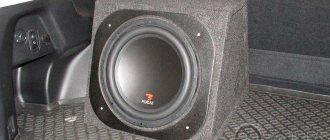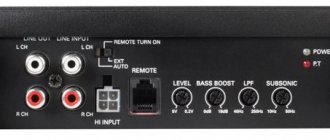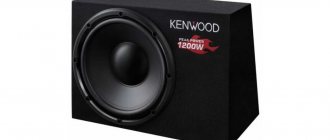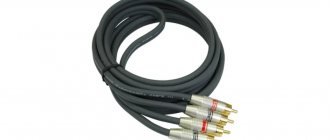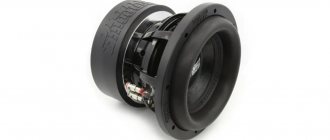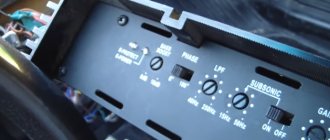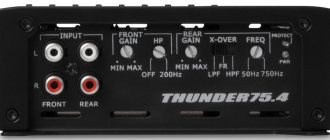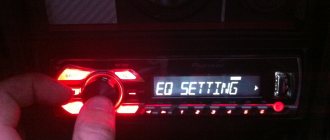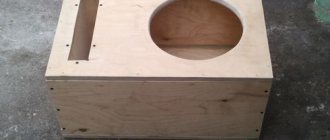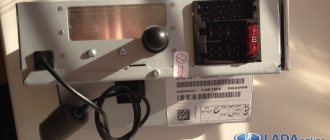The subwoofer speaker is the main component in building powerful and high-quality bass. But the box where you place it plays an equally important role. Depending on the design and type of box, the same subwoofer speaker can be made to play differently. For example, make the bass softer or harder, faster or louder. And if the box is designed incorrectly, you will be completely disappointed in the purchased subwoofer. In this section of our information portal you will find: various drawings of boxes for popular subwoofer speakers designed and tested by professionals. You can choose the box setting that best suits your musical taste. Ready-made detailing with dimensions of parts. that is, you can give the drawing to a company that provides wood cutting services (furniture), and after a certain time pick up the finished parts. Or you can save money and make the cut yourself. In any case, everything is routine work; what displacement of the box is needed, what the length or volume of the port should be, and much, much more we took upon ourselves. All you have to do is download the calculation of the box for the subwoofer, saw it, twist it, tighten it if desired, and enjoy the loud and high-quality bass.
Box for Pride LP 15
Pride LP 15 is the most budget 15-inch subwoofer from Pride. High quality workmanship and a large diffuser stroke and a rated power of 450 watts make this subwoofer a very attractive option for purchasing on a limited budget.
A closed box for Pride LP 15 should have a volume of 60 liters. This is the optimal volume for this subwoofer. The frequency response is completely direct with a slight acoustic gain from 50 Hz and below. An excellent option for everyday wear. Lp15 will play smaller in a box, but there will be noticeably less bass.
Frequency response of 60L box for Pride LP15.
Drawing of a 60L box for Pride LP 15
A closed box for two Pride LP 15 should have a volume of 120 liters. For two Pride LP 15 this is the optimal box volume. If necessary, you can reduce the volume to 100 liters.
Plywood
Wood has been used to make furniture since ancient times, but it was a time when wood was available in abundance, and as wood scarcity increased, plywood was invented for those who could not afford teak, walnut or mahogany furniture. Plywood is made from wood, but every piece of wood is used to minimize wood loss. Plywood has many advantages, such as a variety of sizes and thicknesses. It can easily be covered with paint or laminate in any color or pattern. Plywood production minimizes wood waste, but does not eliminate it.
MDF is an abbreviation for medium density fiberboard. Since the shortage of wood prompted the invention of plywood, MDF is another product that was invented as a wood substitute. MDF is made up of small pieces of wood that are broken down into wood fibers and then compressed in a hydraulic press under very high pressure into a board. MDF boards are manufactured in various thicknesses so that they can be easily used in various industries. These slabs have a very smooth surface and the furniture they make is of very high quality in terms of attractiveness. MDF is easily laminated in a variety of shapes and colors, or painted to your choice. MDF boards are made from wood fibres, hence they have very little screw-driving capacity.
Purpose, design and principle of operation of the CV box
The design of the HF box is aimed at modulating the sound flow. The effect of sound transmission and reflection is used. Thanks to the special housing design, sound harmonization is achieved. This is especially noticeable at low frequencies and when installing a subwoofer. With the appropriate dimensions, the HF box will make the bass sound quite loud, bright, but unusually deep.
Subwoofer box
What materials do we need to assemble the subwoofer?
The material for making the subwoofer box must be durable, dense and well insulating sound. Multilayer plywood or chipboard is perfect for this . The main advantages of these materials are their affordable price and ease of processing. They are quite durable and provide good sound insulation. We will make a subwoofer from 30 mm thick multilayer plywood.
To make a subwoofer box we will need:
- Wood screws (approximately 50-55 mm, 100 pieces)
- Soundproofing material (Shumka)
- Drill and screwdriver (or screwdriver)
- Jigsaw
- Liquid Nails
- Sealant
- PVA glue
- Carpet, approximately 3 meters
- Klemnik
Operating principle
Motorists may be familiar with a resonator, another example of which is the CV box For example, it is used as a functional element of a muffler. In this case, the hollow structure has its own characteristics and another purpose.
From a technical point of view, a resonator is an oscillatory system that accumulates vibrations due to frequency resonance. Typically, the design involves “working” with a limited set of frequency characteristics. Depending on the design, resonators of cumulative and instantaneous action differ.
Homemade wooden box
The storage resonator accumulates external energy by reducing the frequency of internal oscillations. In a mathematical context, any resonator design whose oscillation frequency is greater than the oscillation frequency of the external influence is cumulative. This happens whether the diameter is 10 or 12 inches, but you need to choose a different volume.
Instantaneous action implies the correspondence of the internal oscillatory force in period to external oscillations. Such resonators increase the sound power due to thermal absorption of the surrounding space, shifting the frequency at the input power - changes due to an increase in the playback interval.
The common CV box has a rectangular shape with partitions resembling a caterpillar in arrangement. The appearance will depend on the speaker and its features, size – 10″ or 12 inches. At the moment, you can find drawing diagrams for any frequency device and make a resonator at no extra cost. It will differ slightly from the brand name.
You can make a resonator in a mini version. This solution is shown in the figure.
Drawing of a CV box for 12″
Making a stealth subwoofer with your own hands
Tired of carrying a huge box in your trunk? Then the stealth subwoofer is just made for you. This unique type of case is more practical than the classic box. It doesn't sit in a square box in the middle of the trunk and takes up less space. Often, stealth is installed in the inner part of the wing, sometimes in a niche instead of a spare wheel. The minimum volume of the box that requires a 10-12 inch speaker for normal operation is 18 liters.
To make a passive stealth subwoofer we will need:
- subwoofer;
- protective grille and socket for connection to the amplifier;
- wire for connecting the speaker to the outlet;
- multilayer plywood or chipboard (thickness 20 mm);
- a small piece of fiberboard;
- epoxy adhesive;
- brush;
- fiberglass;
- mounting tape;
- polyethylene film;
- wood screws;
- drill, jigsaw.
Find out what documents are needed to replace your license when changing your last name, and whether you need to take your license again.
Have you recently bought a new car? Read tips on breaking in a new car from experienced motorists.
Here /avtotovary/pokupka-avto/byudzhetnye-krossovery.html you can learn how to properly use and care for an automatic transmission.
After choosing the place where the stealth will be installed, we empty the trunk and begin manufacturing the body. You can remove the trunk trim where the subwoofer will be installed to place it even closer to the fender. First of all, lay a plastic film on the floor of the trunk. It performs two functions at once: it protects the trunk lining from epoxy glue and allows us to make a mount to which we will screw the bottom of the subwoofer. Next, we cover the inside of the wing with mounting tape in two layers.
We cut the fiberglass into small pieces, approximately 20x20 cm. We place pieces of fiberglass onto masking tape and glue them with epoxy glue. It is better to overlap the fiberglass fabric so that there are no obvious joints and seams.
We sculpt layers of fiberglass on top of each other, simultaneously lubricating them with epoxy glue, until the thickness of the sheet reaches 10 mm (about 4-5 layers).
The material will harden in approximately 12 hours. To speed up the process, you can use a lamp. Now we cut out the bottom of the subwoofer and glue it to our body. The joint is treated with sealant or glued with epoxy resin.
In this particular case, the shape needs to be adjusted to the trunk hinges so that our homemade subwoofer does not interfere with its closing. After we cut off all the excess, we cut out the side walls and the top cover from chipboard. We make the rounded part from plywood, we did it “by eye”.
How to calculate a resonator for the Urals yourself?
First of all, we note that the main material for making this audio device is multi-layer moisture-resistant plywood. The speaker input is sized according to the selected model. The volume and design will depend on the technical tasks: interior features, required power and other features.
Designs depending on the direction of the port
The figure shows that the direction of the port and other parameters also influence the design. Sometimes drivers, after making calculations, are concerned that the dimensions are very large compared to the available space in the cabin, so they recommend a design that is suitable for this task.
Other housing options
The photo shows an example of the calculation of the HF box, but in total the cross-sectional area of the tunnel is taken into account (for example, 10″ or 12″), depending on the caliber of the subwoofer, for example, Machete m10d2.
Example
Use the Quarter Wave Box calculation program. You will only need to enter the speaker parameters and box volume. Otherwise you will have to make the drawings yourself.
To do this, use ready-made recommendations - a table with subwoofer sizes for 10, 12 inches and others. The cells show the volume that needs to be taken as a basis to achieve certain audio parameters. A “tuning” is also selected depending on the machine owner’s preferences and frequency. The box can be designed for two or more speakers, they can be different 10″ or 15″.
The proposed variations demonstrate some solutions for organizing a car interior media system that are available for self-production. With a little effort, you will get a high-quality sound system in your car for your new Machete m10d2 or Ural, taking into account the features of your interior and preferences.
Closed box
This type of design is the simplest. A closed box for a subwoofer is easy to calculate and assemble. Its design is a box of several walls, most often 6.
Advantages of ZY:
- Simple calculation;
- Easy assembly;
- Small displacement of the finished box, and therefore compact;
- Good impulsive characteristics;
- Fast and clear bass. Plays club tracks well.
A closed box has only one drawback, but sometimes it is decisive. This type of design has a very low level of efficiency compared to other boxes. A closed box is not suitable for those who want high sound pressure.
However, it is suitable for fans of rock, club music, jazz and the like. If a person wants bass, but needs space in the trunk, then a closed box is an ideal option. A closed box will not play well if the wrong volume is selected. What volume of box is needed for this type of design was long ago decided by experienced people in car audio through calculations and experiments. The choice of volume will depend on the size of the subwoofer speaker.
The most common speaker sizes are: 6, 8, 10, 12, 15, 18 inches. But you can also find speakers of other sizes; as a rule, they are used very rarely in installations. Subwoofers with a diameter of 6 inches are produced by several companies and are also rarely found in installations. Mostly people choose speakers with a diameter of 8-18 inches. Some people indicate the diameter of the subwoofer speaker in centimeters, which is not entirely correct. In professional car audio, it is customary to express dimensions in inches.
Recommended volume for a closed box subwoofer:
- an 8-inch subwoofer (20 cm) requires 8-12 liters of net volume,
- for 10-inch (25 cm) 13-23 liters of net volume,
- for 12-inch (30 cm) 24-37 liters of net volume,
- for 15-inch (38 cm) 38-57 liters net volume
- and for 18 inches (46 cm) you will need 58-80 liters.
The volume is given approximately, since for each speaker you need to select a certain volume based on its characteristics. The setting of a closed box will depend on its volume. The larger the volume of the box, the lower the tuning frequency of the box will be, the bass will be softer. The smaller the volume of the box, the higher the frequency of the box, and the bass will be clearer and faster. You should not increase or decrease the volume too much, as this is fraught with consequences. When calculating the box, adhere to the volume that was indicated above. If there is too much volume, the bass will turn out vague and indistinct. If the volume is not enough, then the bass will be very fast and “pound” the ears in the worst sense of the word.
A lot depends on how the box is configured, but an equally important point is “Setting up the radio.”
Vas indicator
This parameter for speakers can be measured using two methods:
- additional mass;
- additional volume.
In the first case, measurements are made using some weights (10 grams for every inch of diffuser diameter). These could be, for example, weights from pharmacy scales or old coins whose denomination corresponds to their weight. The diffuser is loaded with such objects and its frequency is measured. Next, the necessary calculations are made using the formulas.
When using the additional volume method, the sound emitter is hermetically sealed in a special measuring box with the magnet facing outward. Next, the resonant frequency is measured and the electrical and mechanical quality factors of the speaker, as well as the total, are calculated. Then, taking into account the obtained data, Vas is determined using the formula.
You may be interested in: An astronomer is a scientist who studies astronomy
It is believed that the lower Vas, other things being equal, the more compact design can be used for the speaker. Typically, small values of this parameter at the same resonant frequency are the result of a combination of a heavy moving system and a rigid suspension.
Determine the total volume of the body
By calculating the bass reflex with the JBLSpeakerShop program, we determined the required net volume for our specific subwoofer and the frequency to which the port needs to be tuned. BassPort "told" us the length of the port, as well as the volume that it will occupy. Now we carry out the following arithmetic operations: we add up the volumes - port, pure and displaced by the speaker. The resulting value will be the total internal displacement of our future body. It should be noted that if roundings, stiffeners are used in the body, or it is slotted, then we will have to take into account all these nuances. Approximate calculation of a slotted bass reflex: 1. The net volume is 45 liters.2. Slot port – area 140 cm3, 36 Hz – 8.5 l. Let's add 3.8 liters to the port walls (made of 18 mm plywood).3. Displaced by speaker - 3 l.4. We add these values and get 60.3 liters - the total displacement of the hull.
We obtain the dimensions of the body based on the known displacement
So, we come to the final stage of events. Now we need to calculate what geometric dimensions the bass reflex housing will have if its total displacement is known - 60.3 liters. We take measurements of the trunk, determining acceptable dimensions. For example, a structure 60 cm long and 40 cm high suits us. It remains to find out the width. Let’s decide that we will make the walls of the box from plywood 1.8 cm thick. Now we need to subtract the wall thickness from the length and height of the structure (1, 8x2) and get the following values: length – 56.4; height – 36.4 cm. Next we carry out the following calculations: 60.3x1000:36.4:56.4=29.4. This will be the width of the case, however, without taking into account the thickness of the walls. Let's add it and get 33 cm. This is an approximate calculation of a subwoofer housing with a bass reflex for a specific speaker. Please note that this article is only a general guide; it does not take into account many of the subtleties and nuances that arise during the work process.
Option #3. Calculation of the bass reflex size according to the nomogram
rice.
9. Nomogram In the low frequency range, the operation of a loudspeaker does not depend on the shape of the box or the type of bass reflex, but is determined only by two acoustic design parameters - the volume of the bass reflex box V and its tuning frequency Fb. The calculation of acoustic design basically comes down to finding these quantities. In order to understand the methodology for calculating loudspeakers using a nomogram, let's consider several examples.
Example 1. Calculate the optimal acoustic design for a known low-frequency driver. Let's assume that using measurements the head parameters are determined: Qa=3.2, Qe=0.33, Vas=0.120m3, fs=40 Hz. When operating from an amplifier with zero output resistance (Rg=0), the Qt of the head will be 0.3. Let's mark the point Qt=0.3 on the abscissa axis, draw a straight line perpendicular to the axis through it and find the ordinates of the points of intersection of the straight line with the curves in the upper and lower parts of the nomogram: Vas/V=3, fb/fs=1.25, f3/fs= 1.47. Substituting the measured values of the head parameters Vas=0.120m3, fs=40 Hz into the resulting ratios, we find: V=0.04 m3, fb=50 Hz, f3=59 Hz. Thus, if you do not take measures to additionally regulate Qt, to obtain a smooth frequency response of the loudspeaker, it is enough to place a given head in a bass reflex box with a volume of 0.04 m3 and tune it to a frequency of 50 Hz. The cutoff frequency of the loudspeaker will be equal to 59 Hz.
Example 2. For the same original head with Qa = 3.2, Qe = 0.33, Vas = 0.120 m3, fs = 40 Hz, it is necessary to calculate the parameters of the bass reflex box so that the cutoff frequency of the loudspeaker is equal to 35 Hz. At a specified cutoff frequency, the calculation begins by determining f3/fs. In the case under consideration, f3/fs=0.875. Next, a straight line is drawn through the point with ordinate 0.875 on the f3/fs curve, perpendicular to the abscissa axis, and the coordinates of its intersection points with the Vas/V and fb/fs curves are determined, i.e. Qt=0.415, Vas/V=1.05, fb/ fs =0.93. Substituting the head parameter values Vas=0.12m3, fs=40 Hz into the resulting ratios, we find V=0.114 m3, fb=37 Hz. Therefore, in order to obtain a smooth frequency response of a loudspeaker with a cutoff frequency of f3 = 35 Hz, the volume of the bass reflex box should be 0.114 m3, and the tuning frequency should be 37 Hz. In addition, since the required value of the total Q of the head differs from the measured one (when operating from an amplifier with zero output impedance Qt = 0.3), additional adjustment of this parameter will be required to achieve the desired shape of the frequency response.
Example 3. A low-frequency head is given (Qa=3.2, Qe=0.33, Vas=0.12m3, fs=40 Hz) and the volume of acoustic design is set to 19 V=0.06 m3. It is required to design a loudspeaker with a smooth frequency response. Let's define the ratio Vas/V =2. Through the point with ordinate 2 on the Vas/V curve we draw a straight line perpendicular to the abscissa axis and find the coordinates of its intersection points with the fb/fs and f3/fs curves: Qt=0.345; fb/fs=1,1; f3/fs=1,2. Substituting the values of the head parameters into the last ratios, we find fb=44 Hz, f3=48 Hz. Thus, in order to obtain a smooth frequency response of the loudspeaker with a given head and in a box of the specified dimensions, you will need to adjust the bass reflex box to a frequency of fb = 44 Hz and, using control means, bring the total Q of the head to a value of 0.345.
We obtain the dimensions of the body based on the known displacement
So, we come to the final stage of events. Now we need to calculate what geometric dimensions the bass reflex housing will have if its total displacement is known - 60.3 liters. We take measurements of the trunk, determining acceptable dimensions. For example, a structure 60 cm long and 40 cm high suits us. It remains to find out the width. Let’s decide that we will make the walls of the box from plywood 1.8 cm thick. Now we need to subtract the wall thickness from the length and height of the structure (1, 8x2) and get the following values: length – 56.4; height – 36.4 cm. Next we carry out the following calculations: 60.3x1000:36.4:56.4=29.4. This will be the width of the case, however, without taking into account the thickness of the walls. Let's add it and get 33 cm. This is an approximate calculation of a subwoofer housing with a bass reflex for a specific speaker. Please note that this article is only a general guide; it does not take into account many of the subtleties and nuances that arise during the work process.
